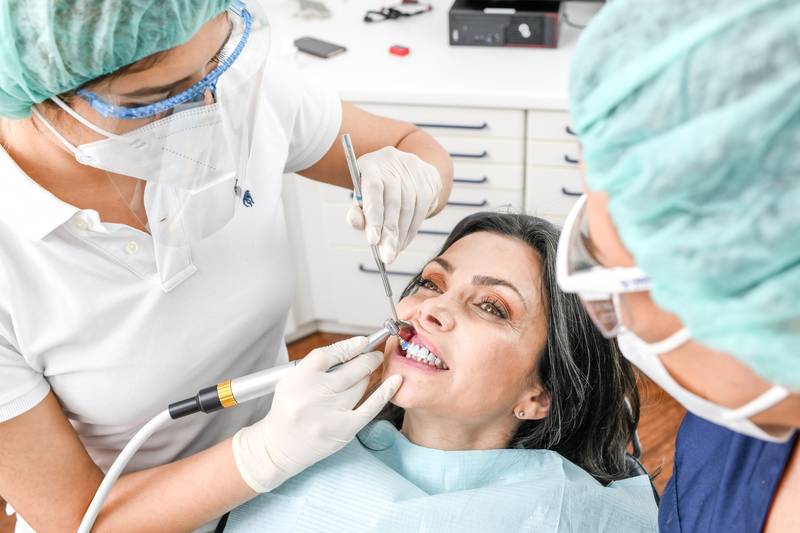Computer-aided design, computer-controlled manufacturing, digital processes — most people are already familiar with these concepts through their application in the production of high-quality products in modern industries. However, they also play a key role in the dental sector. In fact, these technologies now offer dental patients a virtually unprecedented opportunity to directly see and experience the benefits of engineering expertise and medical advancements. Patients’ wishes are the source of new treatment techniques
This was very much on display at the International Dental Show (IDS), whose highlights included a new face scanner that probes the surface of a patient’s face during an x-ray procedure — and does this without using any lasers. The scanner immediately produces a virtual mirror image. This is important because most patients have trouble understanding x-ray images, but dentists can use the image generated by the new scanner to explain the problem and the best way to treat it. What’s more, the image can be altered to look like the result of any one of a number of treatment options, which means patients can play a more active role in treatment decisions. This principle of ‚planning the desired result‛ is increasingly becoming a part of all dental procedures and dental technical laboratory processes. Experts actually refer to it as ‚backward planning‛ — and by nature, the more complex the medical procedures it’s used with, the greater will be the benefits it offers. Take dental implants, for example, the treatment result for which is defined in the consultation. Dentists and dental technicians can now work with data from two and three-dimensional X-ray images recorded using computer tomography and facial scanners, as well as with those produced by classic or — more and more frequently — digital dental impressions. In some cases, different data sets are superimposed over one another. This makes it possible, for example, to create digital and therefore very precise drilling templates that ensure dental implants will ultimately be placed in exactly the right position and at precisely the right angle. Any crowns, bridges etc. subsequently added will also end up in an optimal position. The transition from gum to ‚new tooth‛ can thus be designed in a natural manner. Computer-aided design/manufacturing (CAD/CAM) is, of course, increasingly being used for the production of bridges and crowns as well. A lot is going on in this field because over the last ten years especially, many companies have discovered these techniques’ potential for use in dentistry and learned how they can be optimized for such use. As a result, a type of critical mass has now been achieved. Previously closed systems (materials + software + processing) are now opening up and becoming more and more capable of being networked with other components. This, in turn, has led to the creation of various options for producing crowns, bridges, etc., either directly in a dental practice (chairside), in a practice’s in-house laboratory (labside), at a partner laboratory or manufacturing center, or at an industrial network service provider (outsourcing). Decisions are based on the specific case in question. Digital technologies such as oral scanners are now being used more frequently as an alternative to analogue impressions for patient diagnoses. This eliminates the need for patients to bite into an elastomer mass, which many people find to be an uncomfortable procedure. Sophisticated technologies here make the patient’s experience particularly clear and understandable. In addition, new materials are now often developed with a view toward their suitability for use with digital applications. Several of the ceramic materials presented at IDS come very close to achieving the texture of tooth tissue. Other new developments display outstanding aesthetic properties by automatically blending in with neighbouring teeth (chameleon effect). The targeted reinforcement of base materials is also improving the ability of the dental industry to reconcile translucence with firmness and stability, which is very difficult from an engineering point of view. Even temporary crowns and bridges, such as those used for a few months while patients recover from implant procedures, can be given a very attractive appearance today — thanks to nuanced five-tone internal coatings and CAM-milled plastics. After all, patients want to be able to ‚show themselves in public‛ even when they’re wearing temporary dental replacements.
Under certain circumstances, high-performance plastics could increasingly be used as crown and bridge materials in place of traditional gold material, alloys made of non-precious metals, and ceramics. That’s the situation with crowns and bridges. As far as molars are concerned, other plastics are now available whose innovative glass-fibre reinforcement makes them suitable for use as unbreakable large fillings for back teeth — and at a price that won’t break the bank for patients either. Modern prevention measures
Various companies now offer dentists digital cavity-diagnosis imaging systems that can help prevent extensive tooth damage. One of the most frequent questions asked in this regard is whether modern alternatives (e.g. fluorescence, fibre-optic transillumination) have now eliminated the need for x-rays, thereby making it possible to minimize patient exposure to radiation. A new laser-based device is bringing the dental industry a step closer to this goal. Among other things, the trick here involves using wavelengths in the near-infrared (NIR) region. Innovative laser procedures are also now being used for other types of preventive care. One technique helps fight gum infections, albeit indirectly, by using the lasers to activate a colouring agent (indocyanine green) that docks onto the bacteria cells that cause infections. The agent reduces the number of such cells, all without any side effects or discolorations. Also quite effective are household prevention techniques that have been further developed. Examples here include new electric toothbrush attachments that are better at removing plaque between teeth, and new types of tooth creams that protect gums. Dental treatments are becoming more personalized
Household methods for optimal prevention of tooth and gum damage can be supplemented by professional techniques at the dentist’s practice, where they are increasingly being supported by machines. Care for seniors is particularly important here because elderly patients are often immobile or bedridden and therefore need to be cared for at home, which is where mobile dentist practices come in. Dentists and patients are grateful for any reduction in cables and wires in this context. One item which meets this wish is a new handpiece that can be operated much like a cell phone, and makes a small but effective contribution to preventing the diseases of the mouth that a growing number of patients now suffer from. In other words, dentistry is becoming more personalized in many ways — through the development of solutions for specific patient groups and, more importantly, for individuals. Making the leap from scientific theory to dental practice is one of the most difficult challenges many dentistry students face. Now, however, there’s a new robot that can help them. Pilots first learn to fly on a simulator, so why shouldn’t up-and-coming dentists learn the skills they need on a simulated patient? In this case, the patient is a pleasant-looking ‛female‛ who responds to touch and even winces when it experiences ‚pain‛. It also responds when asked ‚where does it hurt‛? ‚It’s the molar,‛ the robot replies, for example. This almost human-like robot can even be programmed to experience different degrees of ‚pain‛ sensitivity. Along with the devices and systems described here, IDS 2013 also presented a whole range of new products for various dentistry fields. For example, digital impression taking is now making its way into a new area of application — orthodontics — four years after its broad-scale introduction in dentistry. New cost-effective treatment options for correcting minor tooth displacements in adults are currently emerging as well. Conclusion
IDS once again succeeded in showcasing the high level of innovation in the dental industry. Dentists and dental technicians from various disciplines will be able to use some of the new products presented to significantly improve preventive care, treatments, and laboratory procedures in a manner that patients, in particular, are sure to notice. ‚We all enjoyed an International Dental Show that featured many premieres,‛ says Dr. Martin Rickert, Chairman of the Executive Board of the Association of German Dental Manufacturers (VDDI). ‚With all the snow, it was also likely the first ‘white’ IDS. The snow was pretty bad at the beginning, but despite the chaos we set a new record with more than 120,000 visitors. Fortunately, the snow melted to a large extent during the week, which is not surprising, given the red-hot innovations that premiered at the fair.‛ The International Dental Show (IDS) is held in Cologne every two years. It is organized by the GFDI — the Society for the Promotion of the Dental Industry, the commercial enterprise of the Association of German Dental Manufacturers (VDDI) — and staged by Koelnmesse GmbH, Cologne. Note for editorial offices:
Photos from the last IDS Cologne are available in our image database on the Internet (www.ids-cologne.de) in the section “For the Press”). If you reprint this document, please send a voucher copy.
- Alter:
4049 Tage



